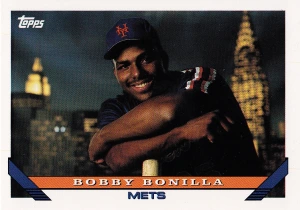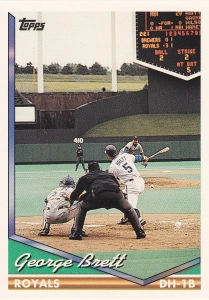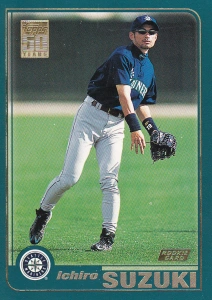Now that I’m above 90% complete on the first set of my collection, I’m allowed (per the Rules of Engagement) to move on to 1981.
Here’s an overview of that set:
- 726 cards in the set, same as the prior year.
- Subsets: League Leaders (1-8), Record Breakers (201-208), Post-season (401-404), Manager / Team Checklists (681-686), Future Stars (26 cards throughout). 66 cards in the set are double printed.
- Set Design: The front features a baseball cap in the lower left corner with position and team name in team colors, bordered by a separate color. The player name is in the bottom of the border, next to the cap, and the “Topps” company name printed in a small baseball in the lower right corner. The red card back features stats from each season and career totals and, if there’s room, personal facts about the player along with a comic type-drawing related to those facts.
- Packs: Cards were issued in 15 card wax packs (30¢ SRP) that came 36 packs per box and 20 per case. Also available in 48 card rack packs, 36 card grocery rack packs, 28 card cello packs (49¢ SRP) and 28 card super cello packs with 3 sticks of gum (59¢ SRP).
- Rookies: Not a great crop of rookies in this set – certainly nothing like the Henderson rookie from the year before. Tim Raines is the best player historically, though the Future Stars card of Fernando Valenzuela (which also contains Mike Scioscia) is the one I think collector’s would most identify. Other rookies include Harold Baines and Kirk Gibson.
- Hall of Fame: There are 46 Hall of Famers in this set, one more than the year before. Brock and McCovey had their last card in 1980 and are not in the set, while Whitey Herzog got hired by the Cardinals in 1980 and thus warranted a card in 1981. Tim Raines and Harold Baines were both in Topps sets for the first time as part of the Future Stars subset.
- Johnny Bench, Bert Blyleven, George Brett, Rod Carew, Steve Carlton, Gary Carter, Andre Dawson, Dennis Eckersley, Rollie Fingers, Carlton Fisk, Goose Gossage, Rickey Henderson, Reggie Jackson, Fergie Jenkins, Jim Kaat, Paul Molitor, Joe Morgan, Jack Morris, Eddie Murray, Jim Palmer, Phil Niekro, Tony Perez, Gaylord Perry, Jim Rice, Nolan Ryan, Mike Schmidt, Tom Seaver, Ted Simmons, Ozzie Smith, Willie Stargell, Bruce Sutter, Don Sutton, Alan Trammell, Dave Winfield, Carl Yastrzemski, Robin Yount, Earl Weaver (manager), Tommy LaSorda (manager), Dick Williams (manager), Sparky Anderson (manager), Joe Torre (manager), Bobby Cox (manager), Tony LaRussa (manager), Herzog (manager) Baines, Raines
- Last Active Player: Rickey Henderson. Jesse Orosco doesn’t have a card in this set, so Henderson is the only player from the set who was still active in 2003.
The wax box has a large baseball in the center with the “Topps” logo and the words “Major League Baseball – the Real one” inside, along with 8 action photos adorning the outside. Similar to the 1980 Astros guy, it might be fun to try to figure out who those players are in the future.
Due to the case “Fleer Corp. v. Topps Chewing Gum, 1980”, this was the first year Topps did not have a complete monopoly. Fleer and Donruss also issued sets in 1981, packaged with bubblegum, though they were required to sell with different “side items” beginning the next years. This was probably interesting since Fernando-mania hit baseball in 1981, and thus collector’s now had multiple venues to obtain a card for the new fad.
Other items of relevance (or irrelevance, depending on your perspective):
Update Set
Topps re-established a tradition, with a twist, by issuing an “update” set – Topps Traded. This set had 132 cards #’d 727 to #858, and, similar to some sets from the 1970’s, included various rookies from the previous year and traded veterans. Different from the 70’s sets – the set was only issued in factory form. I’ll probably end up collecting these sets, though I haven’t completely decided yet.
Parallel Set
Canadian-based O-Pee-Chee again issued a set that was a partial parallel to the Topps base set. Each of the cards in the 374-card set had the same design and photographs as the Topps set, with lighter card stock and bi-lingual backs (French and English). As always, the set leaned toward the Canadian teams; the Manager and Future Stars card for the Expos and Blue Jays were the only subsets included as part of this set.
Promotions
 Every pack contained a scratch off game called Topps “Hit to Win”, where various hits would win you prizes ranging from a Wilson Jim Rice model glove to various supersize glossy photos of “top players”.
Every pack contained a scratch off game called Topps “Hit to Win”, where various hits would win you prizes ranging from a Wilson Jim Rice model glove to various supersize glossy photos of “top players”.- You could again, (though for 75 ¢ now) send in 1 Topps baseball wrapper for an uncut sheet of all the Team Checklist cards.
- For $1 and a baseball wrapper, you could receive a collecting box with 5 “easy-to carry files”.
- For $8 bucks and a wrapper, you could get a “classic stripes cap” of an MLB team of your choice.
Other releases associated with the Topps flagship
#1 – Topps issued a 11 team sets in 1981 as a promotion with Coca-Cola. Each of the 12-card sets features 11 players from the team and an advertising card. The sets have the exact same photo as the base Topps cards. The teams featured are the Reds, Tigers, Red Sox, Cubs, White Sox, Astros, Mets, Royals, Phillies, Pirates and Cardinals. Cards of the Yankees were going to be issues – there are a few known in existence according to the SCD Standard Catalog (Gossage, Reggie, Cerone).
So that’s an overview – a box is on its way to my new residence in New Jersey, so I’m looking forwarding to busting a 1981 box sometime over the next couple weeks. If I was collecting cards around my first birthday. I’d be really stoked around now. Though I’d also be disappointed to know that an impending strike would leave us without baseball for over a month, and would cost the Reds, who had the best overall record in baseball, a chance at the World Series.















